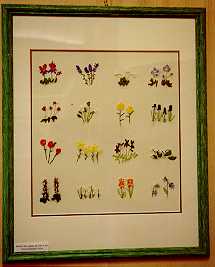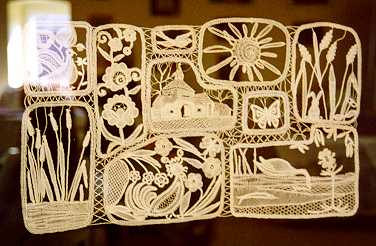Bléharies from March 03 till April 16, 2001 (3/5)

Bléharies from March 03 till April 16, 2001 (3/5) |
 |
|
|
|
Embroidery Crazy ( 1 ) |
Mola ( 2 ) |
1) In the embroidery Crazy, we find the joining of varied tissues, different textures, set by their colours, passing of the light in the dark. The threads are adapted to various used tissues. It's the same for needles. The used points are simple points as stitches of stalk, necklace, cross, slipper, thorn....
2) Mola is a detail of material obtained by superimposing and application inverted by coats of tissues of different colours (2 in 7 coats, sometimes more). This technique comes to us from Indian Kuna, from islands of San Blas Panama. In the language Kuna, Mola is a term which applies to the textile in general . The history goes back up to about 125 years. The Indian are crossed by the physical painting decorated with pearls, in the structured clothes. Certain motives are inspired by the nature where, according to the faith Kuna, every element is lived by the spirit of the Indian mythology, the folklore and the environment. Geometrical figures are from now on a part of the traditional art. 40 at 70 o'clock of work are often necessaires to realize Mola.
 |
 |
|
| Herbarium (silk ribbons and son) | Base of the 2-nd collective project of Wiers's ( 3 ) creative Studios |
3) It is the basic drawing which allowed to realize the second collective project of Studios : " Accessories of fashion of the crazy years ". It is an inspiration déco art. The used thread is some linen or some cotton which offers a bigger variety of colours. If you wish to discover the whole project, you have until April 16, 2001 to go to the exhibition (Route of access at the end of report).

The nature in the neighborhood of Wiers
1Er Collective project of Atelliers Créatifs de Wiers: Duchess
Miniature Mayas is the third project created by Wiers's creative Studios. The persons and drawings were inspired by carvings, potteries or precolombian sculptures. But to see them, it will be necessary to move you!!!